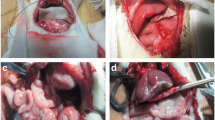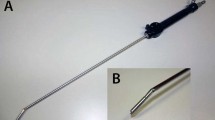Abstract
Background: Increased lipid peroxidation is believed to stimulate liver metastasis in pancreatic cancer. However, the effect of the laparoscopic biopsy of pancreatic lymph nodes on liver metastasis is still unknown. We hypothesized that the effects of a pneumoperitoneum with carbon dioxide (CO2) increase lipid peroxidation and stimulate liver metastasis. Methods: Ductal pancreatic adenocarcinoma was induced in Syrian hamsters (n = 30) by weekly subcutaneous injections of N-nitrosobis-2-oxopropylamine (BOP) for 12 weeks. In group 1, a laparotomy and biopsy of pancreatic lymph nodes was performed. Groups 2 and 3 underwent laparoscopic biopsy with either CO2 or helium. In the 5th postoperative week, the hamsters were killed and the incidence of liver metastasis was analyzed histopathologically. We then made determinations of the level of lipid peroxidation (thiobarbituric acid-reactive substances [TBARS])as well as the activity of glutathionperoxidase (GSH-PX) and superoxidismutase (SOD) in pancreatic carcinoma and liver metastases of the animals. Results: The incidence of liver metastasis was higher in the CO2 group (60%) than in the helium (30%) and laparotomy groups (20%) (p <0.05). the concentration of tbars was greater in pancreatic carcinoma and intrametastatic hepatic tissue than in extratumorous pancreatic and extrametastastic hepatic tissue in all groups. extrametastatic hepatic concentration of tbars was higher in the co2 group (19.4 ± 0.88 nmol/mg protein) than the laparotomy (10.66 ± 0.95 nmol/mg protein) and helium groups (10.79 ± 0.58 nmol/mg protein). gsh-px and sod activity was significantly lower in pancreatic carcinoma tissue and intrametastatic hepatic tissue than in extratumorous pancreatic and extrametastatic hepatic tissue. however, in the co2 group (1.24 ± 0.48 • 107 u/mg protein), extrametastatic gsh-px activity was lower than in the laparotomy (1.73 ± 0.4 • 107 u/mg protein) and helium groups (1.63 ± 0.28 • 107 u/mg protein). conclusion: after laparoscopic biopsy of pancreatic lymph nodes in the co2 group, lipid peroxidation was increased and gsh-px activity was decreased in extrametastatic hepatic tissue compared to the intrametastatic sections. this mechanism may be responsible for the increased liver metastasis in the co2 group.
Similar content being viewed by others
Author information
Authors and Affiliations
Rights and permissions
About this article
Cite this article
Wenger, F., Kilian, M., Proske, J. et al. The impact of laparoscopic biopsy of pancreatic lymph nodes on lipid peroxidation using helium and carbon dioxide in BOP-induced pancreatic cancer in hamsters. Surg Endosc 15, 1150–1155 (2001). https://doi.org/10.1007/s004640090035
Received:
Accepted:
Published:
Issue Date:
DOI: https://doi.org/10.1007/s004640090035




